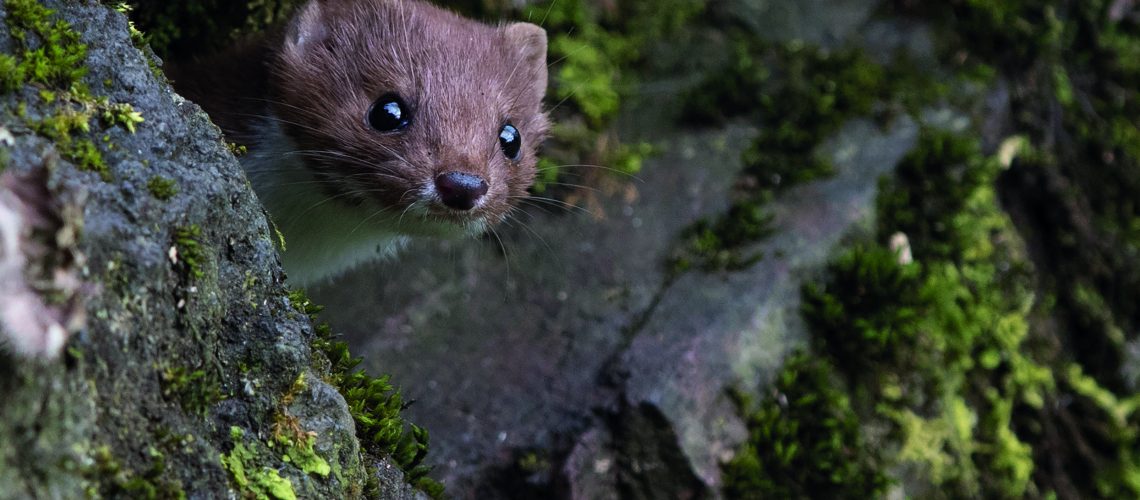
I am at the edge of a small mixed woodland in Herefordshire with Lizzie Croose, Vincent Wildlife Trust’s Senior Carnivore Conservation Officer. We are experimenting with a Mostela. This is a small wooden box with a plastic drainpipe tunnel running through it and a trail camera inside. The camera is set to video and focused on a cut-out section of the drainpipe.
‘The Mostela is based on the idea that stoats and weasels are curious and they like to investigate tunnels and holes – because that is where they find their prey,’ explains Lizzie. ‘The Mostela was designed by a member of the Dutch Small Mustelid Foundation and is one of the tools we use to try and find out more about the current status of stoats and weasels.’
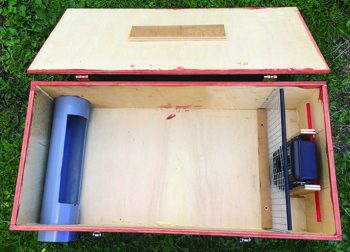
Inside a Mostela showing the tunnel and camera positions. Photo: ©Lizzie Croose
Although stoats and weasels are believed to be common and widespread, they are hugely challenging to study and as a result are categorised as data-deficient: radio-collars have a habit of slipping off their bullet-shaped bodies. The collars are also expensive – and the animal has to be caught in the first place.
Scat surveys are also difficult because although both weasels and stoats will scat on landscape features such as logs or rocks, they tend to use latrine sites near their dens – so first you have to find the den! Surveying for pine martens using scats is far easier because they scat predominantly on tracks and paths as they mark their territory. ‘We have had some success with monitoring the Irish stoat using hair-tubes,’ explains Lizzie, ‘but these tubes have not worked so well in Britain.’
Hair tubes rely on some of the animal’s hair adhering to a sticky pad inside a tube as the creature passes through. The tubes are baited to attract animals inside. The hairs can then be DNA tested – but this is costly.
Installing trail cameras in suitable habitat may result in footage of a passing stoat or weasel, but when foraging, however, these two species move rapidly and often the camera simply captures the animal disappearing out of view. Road casualty surveys are not easy either because the animals are small and easy to miss. Anything, therefore, that might help to further stoat and weasel research is worth a try.
A success story
Stoats and weasels are mustelids and belong to the weasel family. Other family members include polecats, pine martens, otters and badgers. They are all carnivores, but somehow stoats and weasels are considered more akin to serial killers. The rather beautiful pine marten is also a consummate hunter – but never the bad guy. Is it just a matter of looks? In history and literature, stoats and weasels are always the villains – look no further than The Wind in the Willows and its ‘skirmishing stoats and bloodthirsty weasels.’
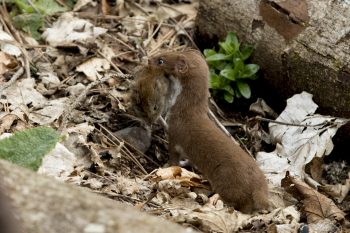
Photo: Weasel with vole ©Robert Cruickshanks
There must be an assumption that their negative image is linked historically to their predation of game and poultry, but do they really deserve such a bad press or is this just fake news? Admittedly a male weasel is not one to be intimidated and can take down a rabbit 20+ times its own weight – although their first choice is the more manageable field vole. ‘Gram for gram they are much stronger than any lion,’ according to New Zealand’s weasel expert Professor Carolyn King. ‘They are bold and powerful predators, but they are also fearless in self-defence,’ explains Lizzie. A remarkable video, Lizzie took on her mobile phone while out cycling shows a stoat fighting with a sizeable and very irate rat. The stoat clearly had no intention of giving up his next meal as you can see when you watch Stoat vs. Rat. Sadly, the phone battery died after some minutes and the animals disappeared into the hedge, but from the sounds heard, it is likely that the stoat was the victor.
Under optimal conditions, stoats and weasels co-exist quite happily; weasels preferring a diet primarily of field voles, while the larger stoat has a preference for rabbit. Other prey species are taken in the absence of voles or rabbits. Stoats and weasels are highly competent climbers and will eat birds and their eggs, but this will generally be of bird species that are common in an area. Weasels are by and large too small to take adult gamebirds, but a stoat will have no problem in predating a pheasant or partridge and, as a result, remain a target for gamekeepers. Stoats and weasels are therefore generalists in the sense that they eat a variety of prey species and can live in a range of habitats as long as prey is present: farmland, moorland, marshes and woodland. Both species frequently den in the burrows of their prey but old stone walls or other structures with suitable cavities will also do the job.
Stoats and weasels are fast breeders, unlike their now-protected pine marten cousin, and this helps to explain their survival, even with intensive control by gamekeepers. Juvenile female stoats, for example, mate in the nest and have an average litter size each year of nine. This contrasts with the slow-breeding pine marten – a female marten does not usually breed until her third year and will only have two or three kits. This slow rate of breeding explains the pine marten’s near extinction in southern Britain as a result of highly efficient gamekeeping during the Victorian heyday of game shooting.
In the absence of any national survey on stoats and weasels, the only data available is via the Game and Wildlife Conservation Trust’s National Gamebag Census. Stoat numbers certainly fell as a result of the myxomatosis outbreak in rabbits but began to recover in the latter part of the 20th century. There is no current reliable population estimate, but it is thought to be something around 440,000. Weasel numbers increased with the arrival of myxomatosis: fewer rabbits meant less grazing and this led to more rough grassland and therefore more voles. As vole populations regularly fluctuate, however, so too does the weasel population. An unreliable estimate for the weasel population is gauged at 450,000. Even allowing for inaccuracy in the figures, stoats and weasels, like most of Britain’s carnivores, are doing well. This is a real success story against the general gloom at the state of our wildlife and wild places, and well-summarised in a paper by Dr Katie Sainsbury, one of Vincent Wildlife Trust’s PhD students.
Encouraging stoats and weasels
The 2019 BBC2 programme Weasels: Feisty and Furious tells the story of the artist Robert E Fuller and his remarkable stoat and weasel community. Robert has helped the animals to thrive in his garden by creating additional denning sites and other habitat features – and has captured much of it on camera and in his artwork. The programme credits are still available and may well give some ideas for attracting these animals to your woodland. Certainly, leaving plenty of brash and log piles around the wood benefits both the small mustelids and other small mammals.
Using a Mostela
We position the Mostela at the edge of the wood along a hedgeline and cover the top with pond liner to keep out the worst of the rain. There is evidence of rabbit activity nearby. ‘Stoats and weasels tend to follow linear features in the landscape, such as hedgerows, woodland edges, streams and field boundaries, so if you place the Mostela in the middle of a wood, you are less likely to record the animals,’ explains Lizzie. Inside the box, we place a tiny container of rabbit scent to act as a lure. Outside, we lay some branches either side of the tunnel entrances to try to funnel in these inquisitive animals. Finally, we camouflage the box using some nearby brash. We will check the box in a couple of weeks and, in the meantime, keep our fingers crossed that a stoat or weasel has indeed passed by.
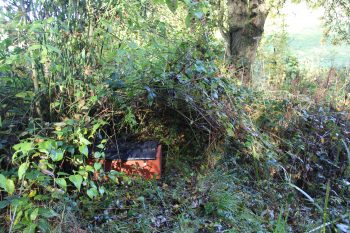
Mostela in position along a hedgeline. Photo: ©Lizzie Croose
If you would like to try and detect the presence of stoats and weasels in your woodland using a Mostela, construction details can be downloaded from the Small Mustelid Foundation. Rabbit scent can be purchased widely online. Even if you do not discover any stoats and weasels in your wood, the Mostela will give you information on other small mammals present. A variety of non-target species has been recorded by Vincent Wildlife Trust staff, including grass snake and adder, rabbit, American mink and small birds, and in Ireland pine martens too have been filmed visiting Mostelas. In another recent experiment with a Mostela, I had 250 camera triggers in two weeks – all mice and voles but rather fascinatingly it included a vole carrying a mushroom in its mouth. An ecologically healthy woodland will include an abundance of small mammals – so this is one way to discover more about the small mammal population in your woodland – even if no stoats and weasels show up.
Spot the differences
Besides being appreciably larger than a weasel (top), the stoat (below) is instantly recognisable by the black tip to its tail. These camera trap pictures really highlight the disparity both in size and markings between these two similar mammals.
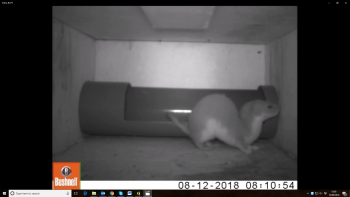
Weasel captured on the Mostela camera
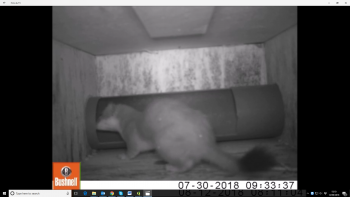
Stoat captured on the Mostela camera
More information
Read Lizzie’s blog Searching for stoats and wondering about weasels.
A Vincent Wildlife Trust paper on the use of Mostelas A pilot study of a novel method to monitor weasels (Mustela nivalis) and stoats (M. erminea) in Britain.
The definitive book on the two species is probably Carolyn M. King’s The Natural History of Weasels and Stoats: Ecology, Behavior, and Management (1989). Also available is a very useful booklet published by The Mammal Society: Stoats and Weasels by Robbie McDonald and Stephen Harris (2006). This costs just £4.99 from NHBS. Although published some 20 years ago, it is still pretty much up-to-date in terms of what we know about Kenneth Grahame’s villainous rogues.
Hilary Macmillan, VWT Head of Communications
This article also appears in Small Woods magazine. Small Woods is the organisation for everyone who is involved in hands-on management of small woodlands, whether as owners, managers, volunteers, woodland and coppice workers or community woodland members Visit Small Woods for more information.
Cover Photo: Weasel ©Robert Cruickshanks